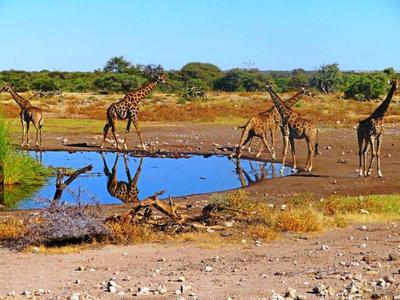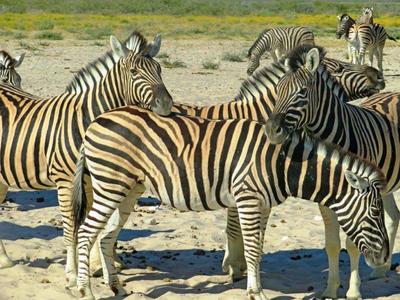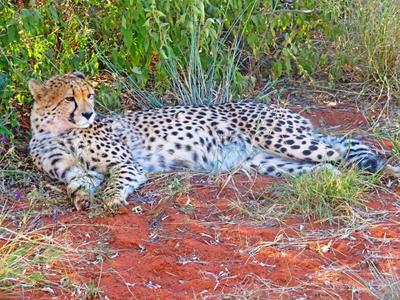naMibia
By Solange Hando. Solange is a professional travel journalist and photographer, editor, public speaker and facilitator. She has contributed to National Geographic and Reader's Digest travel books and published features in 96 titles worldwide. She travels widely but her specialist subjects are Bhutan, where she attended the coronation, Nepal and France. She is a member of the British Guild of Travel Writers, Travel Writers UK and the International Travel Writers Alliance. Her latest book is the Berlitz Guide to Bhutan. She is also the author of, 'Be a Travel Writer, Live your Dreams, Sell your Features' which has been endorsed by Hilary Bradt (founder of the Bradt travel guides) and best selling author Simon Whaley. Search for Solange Hando at http://www.amazon.co.uk
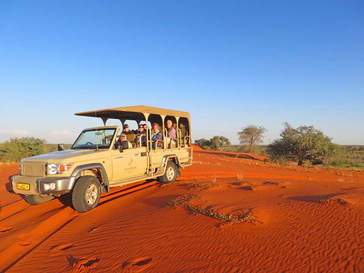
Robots on the road?
'That's what we call traffic lights', laughed Joel. But on this Sunday morning, the tree-lined avenues of Windhoek - the 'windy corner' in the central highlands- were almost deserted. Parliament, hilltop church, heritage railway station, we wrapped up the sights in record time before heading for adventure down south, winding through pastel-coloured hills towards the Tropic of Capricorn. It greeted us on the plain in the middle of nowhere with a donkey and cart plodding along the silky bushman's grass.
'Look, that's a Kalahari Ferrari, farmers like it, safe and cheap'.
Kalahari? That was a dream come true when we reached the lovely Anib lodge with its palm trees, hammocks and pool and lampshades made of ostrich eggs. A 4x4 led us straight into the bush, spotting blue wildebeest, oryx - the national animal- and gambolling herds of springboks, then up into the dunes where we sipped sparkling wine as the sun set all fiery red over the wilderness. We had springbok for dinner -hopefully from a farm- and game promptly became a daily option.
'That's what we call traffic lights', laughed Joel. But on this Sunday morning, the tree-lined avenues of Windhoek - the 'windy corner' in the central highlands- were almost deserted. Parliament, hilltop church, heritage railway station, we wrapped up the sights in record time before heading for adventure down south, winding through pastel-coloured hills towards the Tropic of Capricorn. It greeted us on the plain in the middle of nowhere with a donkey and cart plodding along the silky bushman's grass.
'Look, that's a Kalahari Ferrari, farmers like it, safe and cheap'.
Kalahari? That was a dream come true when we reached the lovely Anib lodge with its palm trees, hammocks and pool and lampshades made of ostrich eggs. A 4x4 led us straight into the bush, spotting blue wildebeest, oryx - the national animal- and gambolling herds of springboks, then up into the dunes where we sipped sparkling wine as the sun set all fiery red over the wilderness. We had springbok for dinner -hopefully from a farm- and game promptly became a daily option.
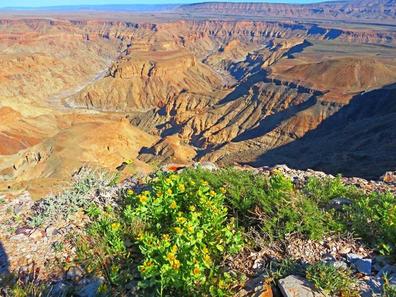
'How far do we drive today?'
'Roughly 400 km but we'll have a break in the quiver forest.'
That was indeed an alien land with eerie looking trees scattered among great piles of rocks as far as you could see. Snakes, scorpions, what lurked in the shadows? I didn't linger for the next day promised a highlight not to be missed, just one of a dozen or more on a two week trip.
I've never been to the Colorado but for me, the second largest canyon in the world would do just as well, 160 km long, up to 27 km wide and 550 metres deep. It's an arduous four day hike at the bottom but the popular walk along the top offers spectacular views, and nothing to stop you tumbling over the edge. The namesake Fish River looped far below, a mere trickle of water, and myriad wild flowers splashed colour along the trail.
'Roughly 400 km but we'll have a break in the quiver forest.'
That was indeed an alien land with eerie looking trees scattered among great piles of rocks as far as you could see. Snakes, scorpions, what lurked in the shadows? I didn't linger for the next day promised a highlight not to be missed, just one of a dozen or more on a two week trip.
I've never been to the Colorado but for me, the second largest canyon in the world would do just as well, 160 km long, up to 27 km wide and 550 metres deep. It's an arduous four day hike at the bottom but the popular walk along the top offers spectacular views, and nothing to stop you tumbling over the edge. The namesake Fish River looped far below, a mere trickle of water, and myriad wild flowers splashed colour along the trail.
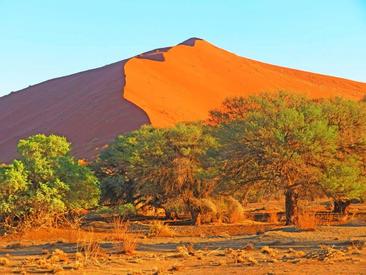
'Keep your eyes peeled, locals on the move', warned the oryx sign as we turned onto a gravel road next morning, looking forward to the 'turbulent' nine hour drive all the way to the Namib desert. Red earth, dark mountains, loads of euphorbia plants that will kill you in 30 minutes and the best apple cake in Namibia (in Helmeringhausen), I enjoyed it all, amazed by Joel who pointed giraffes, elephants, kudus, jackals, zebras and birds in every direction while keeping one hand on the wheel and one eye on the road.
We slept in a starlit camp, full of mysterious noises, then left before dawn for the Naukluft National Park and a dune corridor of ever changing shapes, textures and colours.
'That's number 45, the dune on all the postcards, but I'm taking you to Big Daddy. Ready for the climb?'
Sure. So we crawled up the edge bubbling with excitement until a mighty sandstorm rose across the land, covering up the footsteps we were supposed to follow. Wow! We struggled on, bent in half along an invisible ridge before sliding down haphazardly, digging our heels deep into the fast shifting sand. We landed on a dazzling salt pan where tree skeletons, hundreds of years old, send shivers down your spine.
We slept in a starlit camp, full of mysterious noises, then left before dawn for the Naukluft National Park and a dune corridor of ever changing shapes, textures and colours.
'That's number 45, the dune on all the postcards, but I'm taking you to Big Daddy. Ready for the climb?'
Sure. So we crawled up the edge bubbling with excitement until a mighty sandstorm rose across the land, covering up the footsteps we were supposed to follow. Wow! We struggled on, bent in half along an invisible ridge before sliding down haphazardly, digging our heels deep into the fast shifting sand. We landed on a dazzling salt pan where tree skeletons, hundreds of years old, send shivers down your spine.
Now safe and sound, we were eager to relax on the Atlantic shore but fog was the order of the day, as is often the case. Too bad. So I booked a 600 km flight over the ghostly Skeleton Coast and the magnificent adjoining desert. Next day we sailed in the mist around Walvis Bay, no scenic views but the water was deadly calm and we watched pink jelly fish, dolphins and seals while pelicans with rainbow-coloured beaks wandered on the deck
Next stage on our demanding itinerary was Damaraland in the north west where we marvelled at rock engravings dating thousands of years and appreciated the local folklore in the Living Museum. We stayed a couple of nights and I almost blew the horn to raise the alarm when a leopard growled and scratched outside my tented room.
I should have been used to wildlife by now but our last few days brought the most gorgeous treat of all in the prime conservation areas of Etosha and Mount Etjo. Climb in open safari truck, before sunrise, biting wind, freezing temperatures, blankets, woolly hats, what more could you as for? A waterhole, of course, for that is the best place to observe the animals, waiting for their turn to drink and looking out for each other. Luck was with us for besides the most common species, we spotted hyenas, rhinos, lions and cheetahs. Then we met a white elephant -covered in salt powder from the vast Etosha pan- and a leopard which stopped in front of the truck to do his business and glare back at us. Animals have the right of way all over Namibia.
Next stage on our demanding itinerary was Damaraland in the north west where we marvelled at rock engravings dating thousands of years and appreciated the local folklore in the Living Museum. We stayed a couple of nights and I almost blew the horn to raise the alarm when a leopard growled and scratched outside my tented room.
I should have been used to wildlife by now but our last few days brought the most gorgeous treat of all in the prime conservation areas of Etosha and Mount Etjo. Climb in open safari truck, before sunrise, biting wind, freezing temperatures, blankets, woolly hats, what more could you as for? A waterhole, of course, for that is the best place to observe the animals, waiting for their turn to drink and looking out for each other. Luck was with us for besides the most common species, we spotted hyenas, rhinos, lions and cheetahs. Then we met a white elephant -covered in salt powder from the vast Etosha pan- and a leopard which stopped in front of the truck to do his business and glare back at us. Animals have the right of way all over Namibia.
I loved it but I wasn't so keen on snakes.
'Are you going to the bar, madame? Don't use the path, come this way please, we need to remove the python.'
At least it wasn't a deadly mamba and Namibia is calling back.
For more information on Namibia visit www.namibiatourism.com.na
'Are you going to the bar, madame? Don't use the path, come this way please, we need to remove the python.'
At least it wasn't a deadly mamba and Namibia is calling back.
For more information on Namibia visit www.namibiatourism.com.na
|
Images copyright of the writer
Click on any image to enlarge it |
